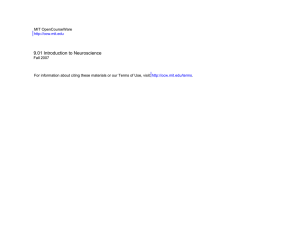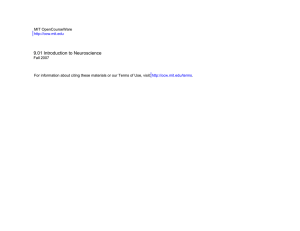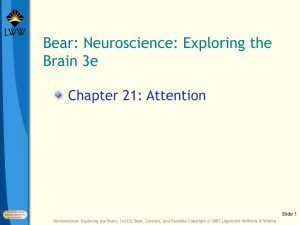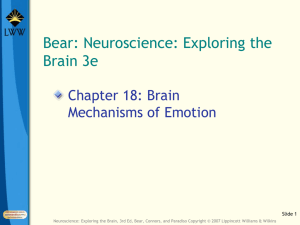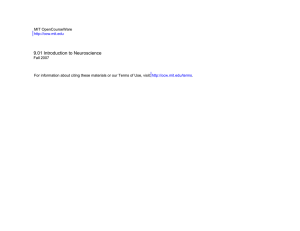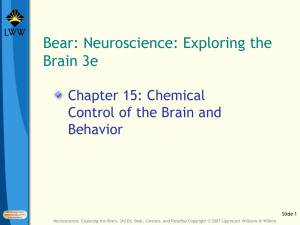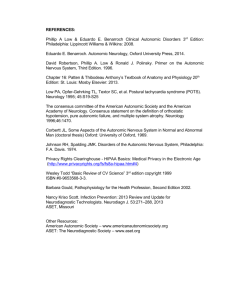Fight-or-Flight Response
advertisement
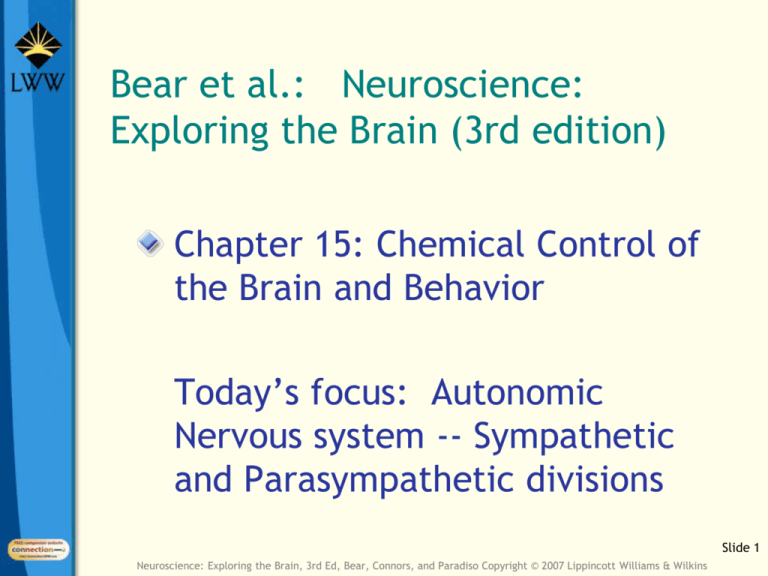
Bear et al.: Neuroscience: Exploring the Brain (3rd edition) Chapter 15: Chemical Control of the Brain and Behavior Today’s focus: Autonomic Nervous system -- Sympathetic and Parasympathetic divisions Slide 1 Neuroscience: Exploring the Brain, 3rd Ed, Bear, Connors, and Paradiso Copyright © 2007 Lippincott Williams & Wilkins The Autonomic Nervous System Divisions of autonomic nervous system (ANS) Sympathetic division (fight or flight) Increased heart rate and blood pressure Depressed digestive function Mobilized glucose reserves Parasympathetic division (rest and digest) Slower heart rate, fall in pressure Increased digestive functions Stop sweating Slide 2 Neuroscience: Exploring the Brain, 3rd Ed, Bear, Connors, and Paradiso Copyright © 2007 Lippincott Williams & Wilkins The Autonomic Nervous System ANS Circuits versus Somatic Motor System ANS Actions multiple, widespread, slow Widely coordinated and graded control Commands all tissues and organs except skeletal muscle Outside CNS Disynaptic efferent pathways Slide 4 Neuroscience: Exploring the Brain, 3rd Ed, Bear, Connors, and Paradiso Copyright © 2007 Lippincott Williams & Wilkins The Autonomic Nervous System ANS Circuits versus Somatic Motor System (Cont’d) Somatic Rapid and accurate Only peripheral targets Commands only skeletal muscle Within CNS Monosynaptic pathway Slide 5 Neuroscience: Exploring the Brain, 3rd Ed, Bear, Connors, and Paradiso Copyright © 2007 Lippincott Williams & Wilkins Fight-or-Flight Response Sympathetic and Parasympathetic Divisions Slide 9 The 12 pairs of Cranial Nerves Mnemonic: On Old Olympus’ Towering Top A Finn And German Viewed Some Hoes Table 1. Cranial Nerves Summary http://www.meddean.luc.edu/lumen/MedEd/grossanatomy/h_n/cn/cn1/t able1.htm The Autonomic Nervous System The Enteric Division Location: Lining of esophagus, stomach, intestines, pancreas, and gallbladder Composition: Two complicated networksmyenteric (Auerbach's) plexus and submucous (Meissner's) plexus Function: Control physiological processes involved in transport, digestion of food Inputs: From brain via axons of the sympathetic and parasympathetic divisions Slide 13 Neuroscience: Exploring the Brain, 3rd Ed, Bear, Connors, and Paradiso Copyright © 2007 Lippincott Williams & Wilkins The Autonomic Nervous System Central Control of the ANS Connections for autonomic control Periventricular zone connections to brain stem and spinal cord nuclei Nucleus of solitary tract Function of solitary nucleus Integrates sensory information from internal organs and coordinates output Slide 14 Neuroscience: Exploring the Brain, 3rd Ed, Bear, Connors, and Paradiso Copyright © 2007 Lippincott Williams & Wilkins The Autonomic Nervous System Neurotransmitters and the Pharmacology of Autonomic Function ANS: Better understanding of drug mechanisms influencing synaptic transmission (vs. CNS) Preganglionic Neurotransmitters Primary transmitter: ACh ACh: Binds to nAChR, evokes fast EPSP Ganglionic ACh: Activates mAChR, slow EPSPs and IPSPs Preganglionic terminals: Small EPSPs Slide 15 Neuroscience: Exploring the Brain, 3rd Ed, Bear, Connors, and Paradiso Copyright © 2007 Lippincott Williams & Wilkins The Autonomic Nervous System Postganglionic Neurotransmitters Parasympathetic: Release Ach Local effect Sympathetic: Release NE Far-reaching effects Parasympathomimetic: Mimic or promote muscarinic actions of ACh or inhibit actions of NE Sympathomimetic: Mimic or promote NE actions or inhibit muscarinic actions of ACh Slide 16 Neuroscience: Exploring the Brain, 3rd Ed, Bear, Connors, and Paradiso Copyright © 2007 Lippincott Williams & Wilkins http://en.wikipedia.org/wiki/Adrenergic_receptor http://www.youtube.com/watch?v=5ePYet3Fbts&feature=related Why Zebras don’t get Ulcers http://www.youtube.com/watch?v=hrCVu25wQ5s Robert Sapolsky – uniqueness of humans Robert Sapolsky’s Reduce Stress Summary 1. Perspective. You probably have enough food to eat, and you probably won’t get eaten by a lion on the way home. 2. Take time to groom someone. 3. Don’t get gored! (it can cause sepsis). Fight-or-Flight Response General Adaptation Syndrome (GAS) • Alarm & mobilization stage – Become aware of stressor • Resistance stage – Preparation to fight the stressor • Exhaustion stage – Negative consequences of stress appear Mnemonic The word "cushingoid" is a useful way to consider the complications and symptoms of Cushing's Cataracts, Ulcers, Skin: striae, thinning, bruising, Hypertension/ hirsutism/ hyperglycemia, Infections,Necrosis, avascular necrosis of the femoral head, Glycosuria, Osteoporosis, obesity, Immunosuppression, and Diabetes



